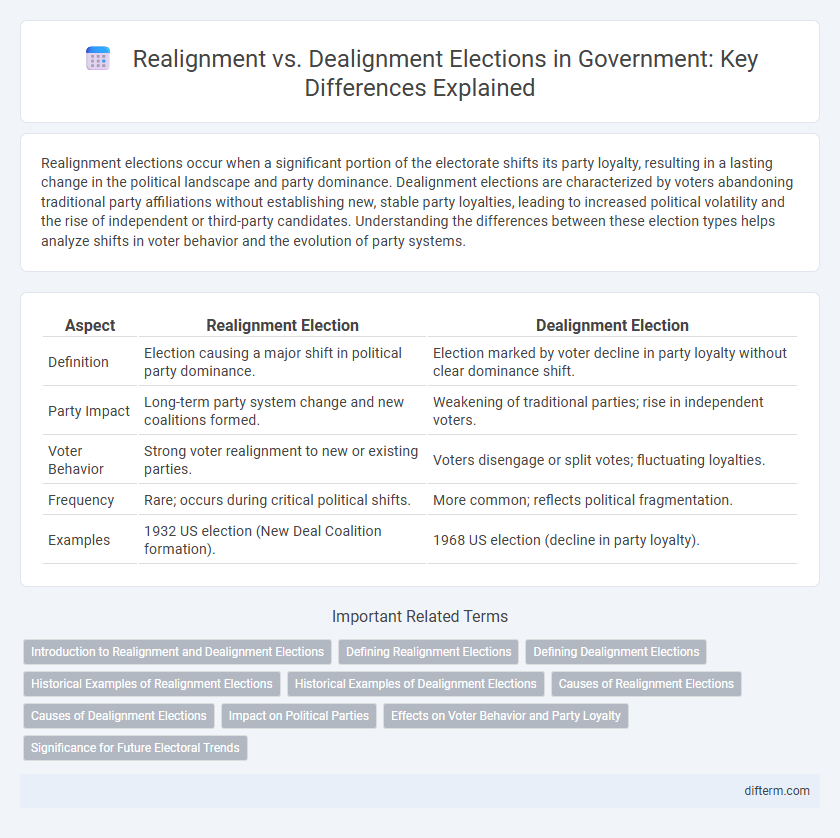Realignment elections occur when a significant portion of the electorate shifts its party loyalty, resulting in a lasting change in the political landscape and party dominance. Dealignment elections are characterized by voters abandoning traditional party affiliations without establishing new, stable party loyalties, leading to increased political volatility and the rise of independent or third-party candidates. Understanding the differences between these election types helps analyze shifts in voter behavior and the evolution of party systems.
Table of Comparison
| Aspect | Realignment Election | Dealignment Election |
|---|---|---|
| Definition | Election causing a major shift in political party dominance. | Election marked by voter decline in party loyalty without clear dominance shift. |
| Party Impact | Long-term party system change and new coalitions formed. | Weakening of traditional parties; rise in independent voters. |
| Voter Behavior | Strong voter realignment to new or existing parties. | Voters disengage or split votes; fluctuating loyalties. |
| Frequency | Rare; occurs during critical political shifts. | More common; reflects political fragmentation. |
| Examples | 1932 US election (New Deal Coalition formation). | 1968 US election (decline in party loyalty). |
Introduction to Realignment and Dealignment Elections
Realignment elections are pivotal moments in U.S. political history where a significant shift in party allegiance and voter behavior occurs, often resulting in lasting changes to the political landscape and party dominance. Dealignment elections, by contrast, reflect a decline in party loyalty as voters increasingly identify as independents or switch allegiances, leading to more fragmented and unpredictable electoral outcomes. Both phenomena underscore evolving voter dynamics and the transformation of political coalitions within government systems.
Defining Realignment Elections
Realignment elections represent critical shifts in the political landscape where a significant portion of the electorate changes its traditional party allegiance, often lasting several decades. These elections typically result in the emergence of a dominant party coalition and a new party system, reshaping government policies and voter behavior. Key historical examples include the 1932 U.S. presidential election, which solidified Democratic dominance through the New Deal coalition.
Defining Dealignment Elections
Dealignment elections are characterized by a significant decline in party loyalty, where voters increasingly support independent candidates or split their votes across party lines. These elections signal a shift away from traditional party identification, leading to unpredictable voter behavior and weakened party influence. Realignment elections, in contrast, involve a lasting transformation in the political landscape with new coalitions emerging and dominant party systems changing.
Historical Examples of Realignment Elections
Realignment elections represent pivotal shifts in political party dominance and voter coalitions, exemplified by the 1932 U.S. presidential election when Franklin D. Roosevelt's New Deal coalition transformed American electoral dynamics. The 1860 election of Abraham Lincoln marked another significant realignment, reshaping the political landscape by intensifying sectional divides and leading to the Civil War. These historical realignment elections demonstrate how critical political, economic, and social upheavals can redefine party systems and voter loyalties over extended periods.
Historical Examples of Dealignment Elections
Dealignment elections historically demonstrate voter shifts away from traditional party loyalties, as seen in the 1968 U.S. presidential election when widespread social unrest and disillusionment with the two-party system led to increased support for third-party candidates like George Wallace. The 1992 election also serves as a dealignment example, where economic dissatisfaction and a fragmented electorate resulted in Bill Clinton's victory amid a weakened Republican hold. These elections highlight periods of voter volatility and fragmented party identification, contrasting the stable partisan alignments typical of realignment elections.
Causes of Realignment Elections
Realignment elections occur when major shifts in political party dominance are triggered by critical events such as economic crises, wars, or social movements that reshape voter coalitions. These elections are often caused by changes in demographic patterns, ideological polarization, or the emergence of new issues that render existing party alignments obsolete. Historical examples include the 1932 election during the Great Depression and the 1968 election amid civil rights struggles, both reflecting profound causes that drive realignment.
Causes of Dealignment Elections
Dealignment elections occur when voters shift away from traditional party loyalties due to widespread dissatisfaction with political institutions, often triggered by scandals, economic crises, or ineffective governance. These elections reflect declining party identification as voters engage in ticket-splitting or support independent candidates. Changes in social cleavages and increased political polarization also contribute to electoral dealignment by weakening established party coalitions.
Impact on Political Parties
Realignment elections cause a significant and lasting shift in the political landscape by altering the core coalition of political parties, often resulting in one party's dominance for decades. Dealignment elections lead to voter volatility and weaken traditional party loyalties, causing fragmented party systems and increased prominence of third parties or independent candidates. Both election types influence party strategies, candidate platforms, and long-term electoral stability, but realignment has a more profound effect on transforming party identities and policy priorities.
Effects on Voter Behavior and Party Loyalty
Realignment elections trigger significant shifts in voter behavior by redefining party coalitions and strengthening long-term party loyalty through the emergence of dominant political ideologies. Dealignment elections, conversely, weaken party ties as voters increasingly identify as independents or switch allegiances, resulting in fragmented voter behavior and decreased party loyalty. These contrasting effects shape electoral outcomes and influence policy priorities, reflecting evolving public sentiments within democratic systems.
Significance for Future Electoral Trends
Realignment elections mark significant shifts in voter coalitions, often establishing dominant party systems that influence electoral behavior for decades, while dealignment elections indicate a fragmentation of traditional party loyalties, leading to increased voter volatility and the rise of independent or third-party candidates. The significance of realignment lies in its role in reshaping political landscapes and solidifying ideological identities, which can stabilize future election outcomes. Dealignment signals a potential transformation in electoral dynamics, highlighting growing voter dissatisfaction and the need for parties to adapt to more fluid and unpredictable voter preferences.
Realignment Election vs Dealignment Election Infographic

 difterm.com
difterm.com